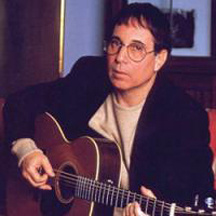Paul Simon (born October 13, 1941) is an American musician, actor, and singer-songwriter. He was part of the duo Simon & Garfunkel, formed in 1964 with musical partner Art Garfunkel. Simon wrote nearly all of the pair’s songs, including three that reached No. 1 on the U.S. singles charts: “The Sound of Silence”, “Mrs. Robinson”, and “Bridge Over Troubled Water”. The duo split up in 1970 at the height of their popularity, and Simon began a successful solo career as a guitarist and singer-songwriter, recording three highly acclaimed albums over the next five years. In 2006, he was selected as one of the “100 People Who Shaped the World” by Time magazine. Among many other honors, Simon was the first recipient of the Library of Congress’s Gershwin Prize for Popular Song in 2007. (More from Wikipedia)
Meanwhile, during March 1964, Tom Wilson was the producer for the first album by Simon and Garfunkel, Wednesday Morning, 3 A.M. Like Bob Dylan’s first album, it was a fairly conventional folk album with numerous traditional folk songs and cover songs, including “The Times They Are A-Changin’”; there were only four songs that had been written by Paul Simon.
Wikipedia describes what happened next: “On June 15, 1965, immediately after the recording session of ‘Like a Rolling Stone’, [Tom] Wilson took the original acoustically instrumented track of Simon and Garfunkel’s 1964 version [of “The Sounds of Silence”], and overdubbed the recording with electric guitar (played by Al Gorgoni and Vinnie Bell), electric bass (Joe Mack), and drums (Buddy Saltzman), and released it as a single without consulting [Paul] Simon or [Art] Garfunkel. The lack of consultation with Simon and Garfunkel on Wilson’s re-mix was because, although still contracted to Columbia Records at the time, the musical duo at that time was no longer a ‘working entity’. Roy Halee was the recording engineer, who in spirit with the success of the Byrds and their success formula in folk rock, introduced an echo chamber effect into the song. Al Gorgoni later would reflect that this echo effect worked well on the finished recording, but would dislike the electric guitar work they technically superimposed on the original acoustic piece.”
For the flip side of the single, Tom Wilson added a song that Simon and Garfunkel had recorded a few months earlier when they were trying for a more “contemporary” sound. “We’ve Got a Groovey Thing Goin’” wasn’t anything like the serious-natured hit song on the “A” side; when the Sounds of Silence album was rushed to the stores after the success of the newly electrified single, the liner notes about this song said simply: “Just for fun”. Paul Simon seemed to like the now somewhat embarrassing Sixties slang term “groovy”; he also wrote “The 59th Street Bridge Song (Feelin’ Groovy)”.
(June 2013/2)
* * *
The second album by the Bangles, Different Light spawned two major hit singles, “Manic Monday” (written by Prince under a pseudonym) and the #1 song “Walk Like a Egyptian”. Several other hits followed, including a tough version of Paul Simon’s “Hazy Shade of Winter” and another #1 song in 1989, “Eternal Flame”.
(November 2013)














